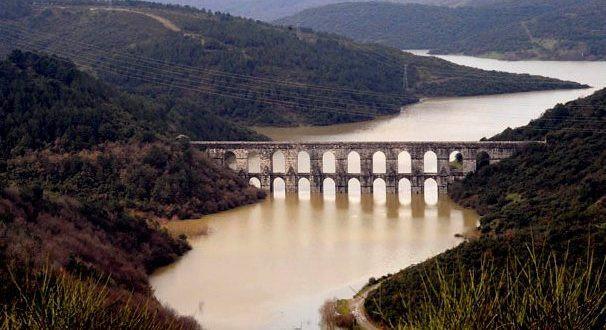
Dams in Turkey are being sapped by low levels of rainfall and temperature levels above seasonal normal, stoking fears about water supply in many provinces in the country, daily Habertürk reported on Jan. 9.
Ten dams in Istanbul have shrunken to 65 percent capacity, according to Istanbul Water and Sewage Administration (İSKİ) data. The figure falls to as low as 20 percent in dams in the capital Ankara and 34 percent in the Aegean province of İzmir.
Water level in Ankara’s Çamlıdere Dam dropped to 18 percent, in Eğrekkaya Dam to 23 percent, 50 percent in Kurtboğazı Dam, 17 percent in Kavşakkaya Dam, 14 percent in Akyar Dam, 30 percent in Çubuk-2 Dam, and 11 percent in Elmadağ Kargalı Dam, making the average water level in all the seven dams 20 percent.
Reaching a critical level, the Elmadağ Kargalı and Akyar dams have stopped pumping water to Ankara. According to Ankara Water and Sewerage Authority (ASKİ) officials, the current water levels in Ankara dams are not sufficient to meet the demands of the capital city’s locals for even a year.
Low water levels in dams in eastern Turkey are also heightening concerns.
Water level in Keban Dam in the eastern province of Elazığ has dropped to 30 percent, where only 4.1 billion cubic meters of water is left.
The water level in Atatürk Dam, on the Euphrates River in the southeastern province of Şanlıurfa, is also at an alarming level, as it dropped from 90 percent to 70 percent between January 2017 and January this year.
The Atatürk Dam is the largest structure ever built in Turkey for irrigation and hydropower generation. It ranks sixth amongst the largest earth-and-rock-filled embankment dams in the world.
The renowned meteorologist Prof. Dr. Orhan Şen said the country is facing a visible drought, but the months of February and March could “compensate” for the loss. “Rainfalls that should have poured have not come yet. So, there is a noticeable drought. Ahead of us are the months of February and March. These months can compensate for the drought,” he said.
Istanbul Technical University Meteorological Engineering Department head Prof. Dr. Mikdat Kadıoğlu also commented on the issue, warning about a possible “agricultural” and “socioeconomic drought.”
“If rainfall levels remain at a level below seasonal norms, we might face agricultural drought in the spring months. In the summer months, on the other hand, socioeconomic drought would become inevitable,” Kadıoğlu said.
Climate expert Prof. Dr. Ümit Erdem pointed to the crucial role of deforestation in drought. “Climate change, as for the whole world, has been affecting Turkey directly. Floods in our country are the most distinct example of this change. Where there is greenery, there is also water; otherwise drought would come. We have been dealing with other things instead of protecting the greenery. The most urgent thing we need to do is to increase the amount of greenery. If instead of building dams, we protect our trees, more affective results can be obtained. Every new dam creates a new ecological system. This situation damages other ecosystems,” Erdem said.
The president of the chamber of agriculture in the southeastern province of Diyarbakır, Süleyman İskenderoğlu, said the low levels of rainfalls put the farmers under “stress.” “Besides them, our dams are empty. As some areas did not receive any rain, seeds stayed on the land as they are, without growing. There are no new plants,” İskenderoğlu said.
On Dec. 28, Water Affairs and Forestry Minister Veysel Eroğlu had said Turkey was experiencing the worst drought in 44 years in 2017 due to a substantial decrease in rain levels.